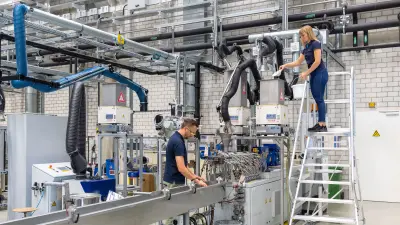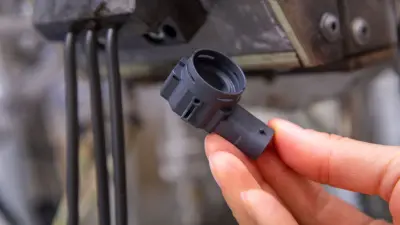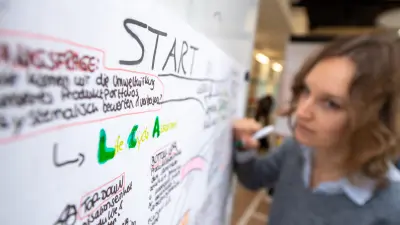From starter battery to sensor
How Bosch wants to bring recycled plastics to the industry
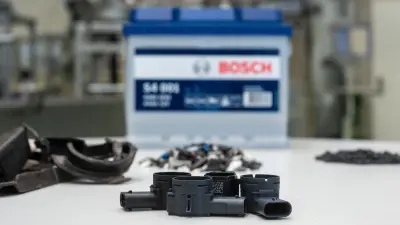
A bed made of used EUR-pallets, lampshades made of old cups – the term upcycling describes the process of creating new things from supposed waste. But producing sophisticated industry technology from recycled material has hardly been possible until now. A team of experts at Bosch Research is now working on realizing precisely that. The main focus here is on the right formulation.
The project: Turning starter batteries into ultrasonic sensors
For two years now, Stefan Apelt and Anika Harbord from Bosch Research have been working at solving a problem: They want to turn old car starter batteries into new housings for ultrasonic sensors that will later be used in vehicle parking pilots. “We want to conserve resources and implement economic sustainability at the same time,” explains plastics expert Gustav Klett from Bosch Automotive Electronics. He supports the team at Bosch Research with his expertise as a longtime developer and expert. His department developed a proposal to use the recyclate in the ultrasonic sensor. But how is the old material supposed to meet the high requirements so that it passes all the tests necessary for use in the highly complex and long-term resistant ultrasonic sensors? This is what Anika and Stefan are conducting research on together with other experts, who are responsible for the life cycle assessment of the material or the subsequent linking with purchasing. For Stefan Apelt, this is more than just a work project: “We want to demonstrate that plastic used properly is good and sustainable.” This way, Bosch is also assuming its responsibility as a company.
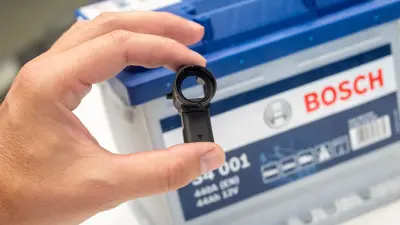
Challenge: the raw material
“One of the biggest research challenges in the field of recycled plastics was to find suitable raw materials and suppliers,” says Anika Harbord. First, sources had to be discovered that could supply the material in sufficient quantity for series production. They also wanted to avoid long delivery routes. Of course, the purity of the raw material is also important. “It must not contain any harmful substances,” explains Anika Harbord.
A material is only suitable for further processing if it meets all these requirements. In the end, the decision was made in favor of old starter batteries, as they were able to do just that.
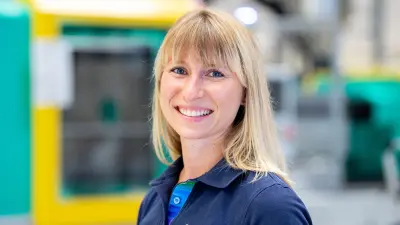
Anika Harbord
- She has been working for Bosch since 2014 and is researching how to use recycled materials for new products in the industry.
- “We are the right people for the job. We love working in the area of recycling.”
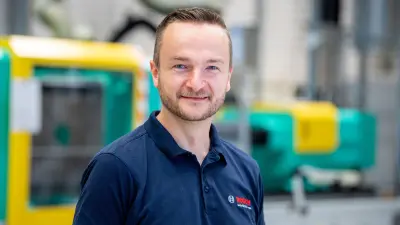
Stefan Apelt
- In 2008, he joined Bosch with the topic of bioplastics, looking to find an alternative for the dwindling crude oil.
- “It feels good to do something to help the environment.”
Sustainability goals
Taking responsibility and recycling the waste generated by Bosch
Improving the carbon footprint of products
Climate protection with resource efficiency
Challenge: the formulation
Pure plastic, laser markers, glass fibre, additives to prevent oxidation – all these things belong in a stable plastic compound. In order to find the right mixture of these components for the sensor housings, innumerable tests were required. For these tests, the team has its own compounding facility for the production of the plastic mixtures. On this machine, smaller quantities of the material were mixed recipe by recipe. A total of three compositions made it to the shortlist for use in the ultrasound sensors and were extensively tested in terms of their mechanical and electrical properties.
After all, the recycled material had to be able to keep up with the material used so far, be robust and laser-markable. In simulation tests, heat resistance, ductility and resilience were examined carefully. The color was also a challenge for the team. “The plastic polypropylene was previously only available as a recycled material in black. But we also needed it in other colors,” explains Gustav Klett. One recipe was able to prevail in the end and meet all requirements. With this data, the purchasing department was finally convinced to include a recycling company as an official Bosch supplier.
From the battery to the ultrasonic sensor housing – how the process works

Next step: mass production
For the time being, the material is still being tested in small quantities in pilot projects. However, we needed a partner to ensure that in future every ultrasonic sensor at Bosch can be manufactured using recycled plastic. The team looked for a company that had the right machines to produce the material in quantities suitable for mass production – of course, according to the special Bosch formulation. And that was not so easy. Using recycled materials for technical components was largely unknown ground for manufacturers. "We had to minimize the technical concerns and convince the suppliers to implement the whole process according to our ideas," says the responsible purchaser Maikel Werk. It was precisely when faced with such challenges that the team benefited from the combination of research, product development and purchasing expertise. In the end, a recycling company for starter batteries became the partner. As soon as mass production is up and running, other Bosch colleagues, such as the purchaser involved in the project, Maikel Werk and developer Michael Schneider, can also opt for the sustainable material as a matter of course. “Our development is demonstrating that it works. It should be an internal incentive for developers to dare to use a recyclateevery now and then.” Creating a second life cycle for materials is a first step towards sustainable products. This is first and foremost demonstrated by the life cycle assessment calculation prepared in-house, which is mapped in a product-specific manner thanks to LCA expert Elena Wege.
- The material must withstand temperatures of 130 degrees for 300 hours.
- It takes 4000 tons of material to produce 800 million ultrasonic sensors.
- An average German car would have to drive 2.6 million kilometers a year to produce the CO₂ that Bosch saves by replacing new materials with the recyclate it has developed. That is a total of 500 tons of CO₂ per year.
The future: new projects
At the same time, work is already underway on other projects, such as solutions for automotive interior applications using recycled material. “There is great potential to score points with recyclates,” says Stefan Apelt. Integrating the recycling into other product areas will also be a challenge. However, the team at Bosch has already taken the most important steps towards establishing the recycled material. “It took a lot of discussions and conversations to convince colleagues that recyclate is not inferior, but that something can be made of it,” says Gustav Klett.
Anika Harbord is convinced that it will be a little easier with coming projects than with the first one. “When we started, everyone thought it was nice, but nobody wanted to deal with the topic of recycling. Nevertheless, we kept going and tried to carry everyone along. We have succeeded in this, and that only works if you have real enthusiasm for the topic.”

The next challenge that the team around Anika and Stefan would like to tackle is the optimized recycling of reinforced plastics, e.g. with glass fibers. Up to now, ideal approaches to solving the problem of how filled plastics can be recovered and processed into new technical products have been lacking. This is why the solution of energy recovery is used in most cases for this valuable category of materials. This means that it is burned and used in the form of heat or electricity, or it is processed into a substitute fuel. Bosch Research is pursuing the goal of being able to recycle these filled plastics in the future.
The goal: circular economy
In the long term, however, the team has a larger, even more sustainable goal in mind: “We want to close the cycle, i.e. recover the material at the end of the life cycle and send it back into the cycle,” says Stefan Apelt. At the moment, this does not work yet. The sensors are installed in cars and are not returned to Bosch. “However, the project is a step on the way towards circular economy,” Stefan Apelt is convinced. If the process works in this case, it should be transferred to other product categories as soon as possible, and further formulations should be developed.
Ideally, the new, recycled components should then at some point remain in-house and the products should be completely recycled. For Stefan Apelt, one thing in particular is important: “When you think about how long it takes for discarded plastic to degrade if you don’t reuse it, it’s a good feeling to know you’re not just leaving the future generations with garbage.”
